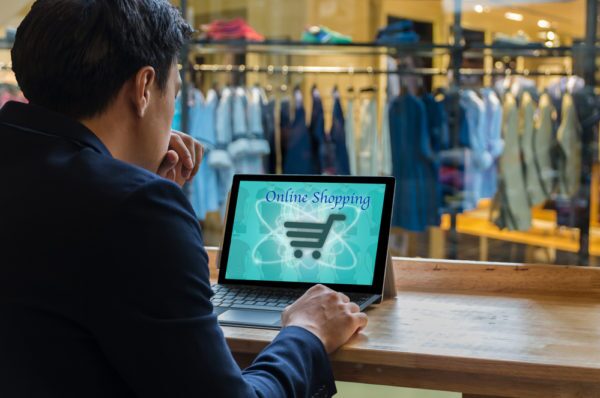For retailers, “change” and “innovation” have historically been words only whispered in their halls and conference rooms – aspirations that often proved too difficult to initiate with their limited toolsets. The events of the past two years have changed that, and innovation is now a need, not simply a want for the retail industry.
Luckily, today’s available retail business solutions are both easier to use and better aligned to business needs, providing a much-needed answer for our new age of customer-focused, customer-everywhere retail business model.

Forces Driving Business Model Innovation
While growing quickly, eCommerce remains a smaller revenue channel for traditional retailers. But this isn’t just about eCommerce, it’s about how gaining a complete understanding of your final customers has become mission-critical: who they are, what they do, where they visit, what they click, etc. In 2019, Gartner predicted that eCommerce would no longer be a differentiator for big and small retailers, physical stores or non-store retailers alike by 2023, and the pandemic has only accelerated that timeline.
Being digital isn’t enough. Retail businesses need technology investments to innovate how they engage, convert, and retain customers to deliver the kinds of experiences that today’s consumers expect. For some, that means re-examining their sales process and store operations right down to its core. Is the current operating model the right one for today? Or tomorrow? Does it match customer preferences and demands? Are there new ways for your retail business model to meet the demand that aligns better with the organization’s goals and increase value proposition?
[FREE GUIDE] LEARN HOW TO BUILD THE “LAUNCHPAD” FOR END-TO-ENDLESS INNOVATION
Shifting consumer expectations and demand are drivers that need to be taken into account in the current retail space. As DMI’s Director of Business Development, Phillip O’Brien, explains, “Consumers are becoming habituated to the greater level of personalization and consumer experience that’s now possible, as well as the multitude of different strategies to engage with brands, whether that’s via technologies like augmented reality (AR) or newer channels like Instagram and TikTok that retail companies can monetize. Companies need to innovate their business models to meet these higher customer expectations, or they’ll lose out to their retail competitors that do.”
Indeed, technology plays a role in the end consumer, but really as an enabler, not a driver. As retailers work to become more nimble and adapt to constantly changing market conditions and expectations, organizations must first lead with their strategy: strategy around their customers, markets, products, and pricing. Once this strategic direction has been developed, then it’s time for the decision-making authority to define the right technology roadmap to support it. It is this process of strategy before architecture that will ensure a retail business is nimble today, scalable for tomorrow, and ready for whatever comes next in the retail industry.
Two smart ways forward-thinking retail businesses have been responding to these changing market forces and competitive pressures is by adopting a composable commerce approach, or by embracing an enterprise marketplace business models – like Macy’s, Urban Outfitters, Forever 21, Express, Lands’ End, Office Depot and Kroger have done, to name a few.

The Rise of Composable Business
As the name suggests, the defining strength of composable commerce lies in its ability to enable companies to customize their commerce experiences via a retail business architecture designed around a modular approach: best-in-breed solutions can be assembled into a tech stack that’s customized to meet the unique needs of a business and its customers.
Composable technology makes it easy to align your retail technology with organizational goals, instead of being held back by what your platforms and solutions can’t do. As championed by the MACH Alliance (Microservices based, API-first, Cloud-native SaaS and Headless), “from the supply chain to end consumer experience, every component is pluggable, scalable, replaceable, and can be continuously improved through agile development to meet evolving business requirements.”
Living in an age of accelerated change makes future-proofing businesses all the more difficult, and many retailers are lagging when it comes to composable technology adoption to address the challenge in the retail industry. However, that looks set to change based on recent research commissioned by the MACH Alliance. Their study found that greater adoption of the retail business model is high on the agenda for tech leaders over the next 12 months, driven in large part by a need for a greater ability to make customer experience improvements at speed. Unsurprisingly, the biggest barrier to adoption is the usual innovation-killer: resistance to change. When has that ever been a legitimate reason to not improve your business?
A Recent Evolution in the Marketplace Model
When it comes to marketplaces, third-party marketplaces like Amazon have been a boon for many sellers. Their relative ease of listing products for sale, along with gaining immediate access to large audiences and logistics capabilities, makes them a very attractive option with low barriers to entry. This is especially true for a retailer that are just getting started in eCommerce. Why don’t all brands choose to sell on such marketplaces?
There are some significant downsides to consider, such as diminished profit margins due to the inability to list a higher price from other competitors and customer lifetime value, difficulty in standing out from the competition, and losing control of things brands value highly, like the customer experience, end-customer data, and brand identity.
Fortunately, for retailers that want to actually ‘own’ the customer that buys their products and services – as well as retain control over their margins (shhh, profit) – there’s a newer option that’s gaining significant traction: the enterprise marketplace.

eCommerce and enterprise marketplace
Over the past year, e-commerce has steadily grown. eCommerce technology now exists that allows companies to easily create and scale their own marketplace. They can easily onboard third-party sellers to list complementary products and services alongside their own, gaining new revenue streams and a host of other benefits marketplace operators like Amazon enjoy: new customers, assortment growth, range extension, and testing within new product categories (all without the associated inventory risk), a greater share of wallet, and the ability to respond to trends in real-time that physical store locations cant do, acquire a wealth of customer data, and meet customer demand for broader options and one-stop shopping. As the operator, brands have control over which sellers they want to allow onto their curated marketplaces, as well as which party is responsible for things like customer service and logistics.
Enterprise marketplaces in the retail industry can be highly effective for both B2C and B2B business models. And in the case of manufacturers who sell exclusively through distributors, retailers, and other channel partners, they offer a tremendous opportunity to enable selling direct-to-consumer without creating channel conflict. This is because manufacturers can easily onboard their channel partners as “sellers” on their marketplaces.
This B2B2C business model avoids competition with channel partners while gaining control over the customer experience offered and the deep insights into end customers that DTC companies enjoy. That serves to fill a HUGE information gap for manufacturers.
Understanding Your Path and Enabling Agility
These innovations are all supported by the organization’s underlying technology, making it more important than ever that retailers focus on agile solutions that support innovation and change, and enable the ability to rapidly adapt their retail business model to changing market conditions.
However, the number of solutions in the market has expanded exponentially, so it can be a real challenge for companies to figure out which retail business model best aligns with organizational challenges and goals.
Understanding and vetting solutions isn’t a retailer’s main business, making it advantageous to work with a trusted partner to help distill all of the information and options into a cohesive plan and business model. For instance, DMI has helped hundreds of clients across industries and around the globe with digital transformation initiatives, giving us a breadth of experience and capabilities that enable a holistic approach to help organizations solve their most pressing challenges or meet their loftiest goals.
DMI offers a free Commerce Strategy Assessment to qualified companies, where we’ll review your current online experience and technology stack to evaluate how well they support your strategy, and generate a personalized commerce score with actionable steps to improve the areas we highlight.
Contact us to learn how DMI can help you define the right technology and path to meet your digital transformation goals.
[hubspot type=cta portal=8444324 id=5af1078d-cc0c-40a2-b89f-89ee383b80ad]


